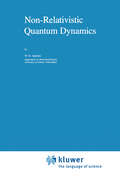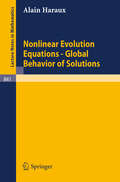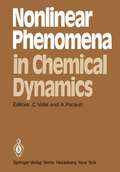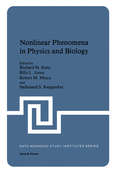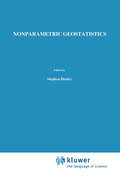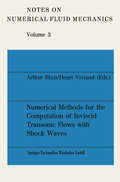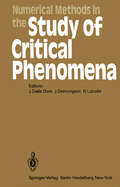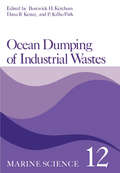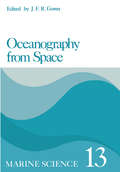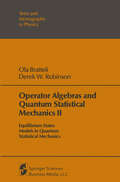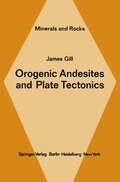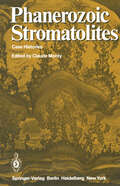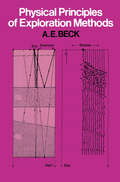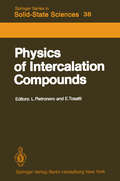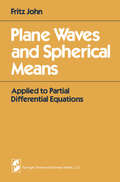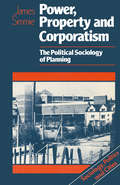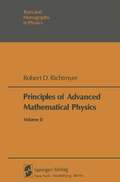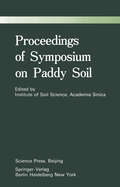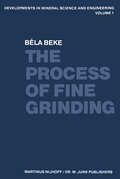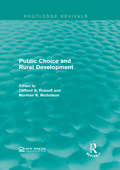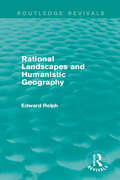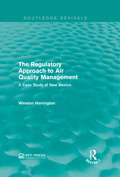- Table View
- List View
Non-Relativistic Quantum Dynamics (Mathematical Physics Studies #2)
by W.O. AmreinThe bulk of known results in spectral and scattering theory for Schrodinger operators has been derived by time-independent (also called stationary) methods, which make extensive use of re solvent estimates and the spectral theorem. In very recent years there has been a partial shift of emphasis from the time-indepen dent to the time-dependent theory, due to the discovery of new, essentially time-dependent proofs of a fair number of the principal results such as asymptotic completeness, absence of singularly con tinuous spectrum and properties of scattering cross sections. These new time-dependent arguments are somewhat simpler than the station ary ones and at the same time considerably closer to physical in tuition, in that they are based on a rather detailed description of the time evolution of states in configUration space (whence the designation "geometric methods" used by some authors). It seemed interesting to me to present some of these new meth ods from a strictly time-dependent point of view, by considering as the basic mathematical object strongly continuous unitary one parameter groups and avoiding the spectral theorem completely. The present volume may be viewed as an essay in this spirit. It is an extended version of a course taught in 1979 at the University of Geneva to undergraduate students enrolled in mathematical physics.
Nonlinear Evolution Equations - Global Behavior of Solutions (Lecture Notes in Mathematics #841)
by Alain HarauxNonlinear Phenomena in Chemical Dynamics: Proceedings of an International Conference, Bordeaux, France, September 7–11, 1981 (Springer Series in Synergetics #12)
by C. Vidal A. PacaultAn international conference. titled Nonlinear Phenomena in Chemical Dynamics was held in Bordeaux on September 7-11, 1981. The present volume contains the text of lectures and abstracts of posters presented during the meeting. This conference is part of a series of scientific multidisciplinary meetings in which chemistry is involved at various levels. Amongst the most recent ones let us mention Aachen 1979, Bielefeld 1979, New York 1979, Elmau 1981. In addition, this meeting is a direct extension of the first one that took place in Bordeaux in 1978 on the topic "Far from equilibrium: instabilities and structures," at the conclusions of which we could write (cf. Far fram Equilibrium, Springer Series in Synergetics, Vol. 3): "The three key words, far fram equilibriUm, instabilities and structuPes, best illustrate the new concepts which emerge from the description of the dynamics of various systems relevant to many different research areas. " The present proceedings show how much these remarks have remained true, even though substantial progress has been achieved during the three last years. To get a ,deeper experimental knowledge of open reacting systems, to model and simulate reaction-diffusion systems, to develop the mathematical theory of dynamical sys tems, these are the main direction~ in current investigations.
Nonlinear Phenomena in Physics and Biology (Nato Science Series B: #75)
by Richard H. EnnsThe Advanced Study Institute (ASI) on Nonlinear Phenomena-in Physics and Biology was held at the Banff Centre, Banff, Alberta, Canada, from 17 - 29 August, 1980. The Institute was made possible through funding by the North Atlantic Treaty Organization (who sup plied the major portion of the financial aid), the National Research and Engineering Council of Canada, and Simon Fraser University. The availability of the Banff Centre was made possible through the co sponsorship (with NATO) of the ASI by the Canadian Association of Physicists. 12 invited lecturers and 82 other participants attended the Institute. Except for two lectures on nonlinear waves by Norman Zabusky, which were omitted because it was felt that they already had been exhaustively treated in the available literature, this volume contains the entire text of the invited lectures. In addition, short reports on some of the contributed talks have also been included. The rationale for the ASI and this resulting volume was that many of the hardest problems and most interesting phenomena being studied by scientists today ar.e nonlinear in nature. The nonlinear models involved often span several different disciplines, °a simple example being the Volterra-type model in population dynamics which has its analogue in nonlinear optics and plasma physics (the 3-wave problem), in the discussion of the social behavior of animals, and in biological competition and selection at the molecular level.
Nonparametric Geostatistics
by S. HenleyThe ideas in this book have been developed over the past three or four years while I was working at the Institute of Geological Sciences and later for Golder Associates. During that time all of the geological modelling and resource estimation studies I participated in had data that were non-ideal in one respect or another (or just plain 'dirty'): the standard ways of handling the data with kriging or with simpler parametric methods gave reason able results, but always there were nagging doubts and some lack of confidence because of the corners that had to be cut in generat ing a model. The bimodal distribution that was assumed to be 'close enough' to normal; the pattern of rich and poor zones that was not quite a trend yet made the data very non-stationary; and the many plotted variograms that would not fit any standard model variogram: these all contributed to the feeling that there should be something that statistics could say about the cases where hardly any assumptions could be made about the properties ofthe parent population.
Numerical Methods for the Computation of Inviscid Transonic Flows with Shock Waves: A GAMM Workshop (Notes on Numerical Fluid Mechanics #3)
by Arthur Rizzi Henri ViviandNumerical Methods in the Study of Critical Phenomena: Proceedings of a Colloquium, Carry-le-Rouet, France, June 2–4, 1980 (Springer Series in Synergetics #9)
by J. Della Dora J. Demongeot B. LacolleThis volume contains most of the lectures presented at the meeting held in Carry-le nd Rouet from the 2 to the 4th June 1980 and entitled "Numerical Methods in the Study of Critical Phenomena". Scientific subjects are becoming increasingly differentiated, and the number of journals and meetings devoted to them is continually increasing. Thus it has become very difficult for the non-specialist to approach subjects with which he is not familiar. Hence the purpose of our meeting was to bring together scientists from different disciplines to study a common subject and to stimulate discussion' between participants. We hope this goal was reached. The lectures are grouped in five chapters and, inside the first and the second chapter, under two headings. In each group they are classified in alphabetical order by author. We are pleased to publish these Proceedings in a series whose multidisciplinary character has been emphasized from the beginning. We are indebted to all who provided us with their help, particularly to Mrs. A. Litman of the Centre International de Rencontres Mathematiques at Luminy (C.I.R.M.) whose kindness and efficiency are well known; from the practical point of view, the meetings were organized within the scientific framework of the G.I.S. No.19 (C.N.R.S.), with the participation of the University of Grenoble.
Ocean Dumping of Industrial Wastes (Marine Science #12)
by Bostwick KetchumIn recent years there has been an increased realization that the casual disposal of wastes can lead to a deterioration in environmen tal quality with substantial impacts on society. The management of waste disposal practices must consider the various alternatives of discharging and decomposing wastes on land, in the atmosphere, and in the marine environment. Up until 1972 ocean dumping was used increasingly to dispose of sewage sludge, industrial wastes, and dredged material. In subsequent years regulations were developed to reduce and minimize ocean dumping. These regulations were prompted often by ignorance of the possible effects of waste disposal in the ocean rather than by knowledge that such ocean dumping was detrimen tal to the marine environment or to man. The relationship between waste disposal and the oceans can be viewed in either of two ways. One may want to assure that waste disposal procedures do not alter adversely the marine environment, or one may choose to utilize the ocean as a waste depository to reduce the burden placed on the con tinental ecosystem and on the atmosphere. From either perspective it is essential that there be an adequate base of technical information to assess the fate and effects of wastes introduced to the ocean. A series of original technical papers has been compiled in this book to present some of the recent results of research on industrial waste disposal in the ocean.
Oceanography from Space (Marine Science #13)
by J. F. GowerThis volume is based on the proceedings of the COSPAR/SCOR/ IUCRM Symposium "Oceanography From Space" held in May 1980 in Venice, Italy. COSPAR (The Committee for Space Research) suggested holding a joint symposium with SCOR (The Scientific Committee for Oceanic Research) as a major review of space oceanography. Since this meeting fitted well with a series of colloquia organized by the IUCRM (The Inter-Union Commission on Radio Meteorology), these three bodies joined in sponsoring the meeting. The conference was hald 16 years after the first discussions of possible spaceborne observations of the ocean at a meeting organized in 1964 in Woods Hole. Gifford'Ewing was then keen to see oceanography benefit from the new satellite technology being developed, and he begins this volume by noting that most of the suggestions put forward in 1964 have now, at last, been successfully demonstrated in practice. The papers that follow show the variety of measurement techniques available or possible, and many of the types of studies in which they can be used. Papers are arranged in a general section, and in 6 specialized sections each of which starts with a brief introduction summarizing important results.
Operator Algebras and Quantum Statistical Mechanics II: Equilibrium States Models in Quantum Statistical Mechanics (Theoretical and Mathematical Physics)
by Ola Bratteli Derek William RobinsonFor almost two decades, this has been the classical textbook on applications of operator algebra theory to quantum statistical physics. Major changes in the new edition relate to Bose-Einstein condensation, the dynamics of the X-Y model and questions on phase transitions.
Orogenic Andesites and Plate Tectonics (Minerals, Rocks and Mountains #16)
by J. B. GillStudents of a phenomenon as common but complex as andesite genesis often are overwhelmed by, or overlook, the volume and diversity of relevant information. Thus there is need for periodic overview even in the absence of a dramatic breakthrough which "solves the andesite problem" and even though new ideas and data keep the issues in a state of flux. Thus I have summarized the subject through mid·1980 from my perspective to help clarify the long-standing problem and to identify profitable areas for future research. Overviews are more easily justified than achieved and there are fundamental differences of opinion concerning how to go about them. It is professionally dangerous and therefore uncom mon for single authors, especially those under 35 such as I, to summarize a broad, active field of science in book-length thor oughness. Review articles in journals, multi-authored books, or symposia proceedings appear instead. The single-authored approach is intimidating in scale and can result in loss of thoroughness or authority on individual topics. The alternatives lack scope or integration or both.
Phanerozoic Stromatolites: Case Histories
by Claude MontyDuring the 2nd International Symposium on Fossil Algae, organized by the University P. & M. Curie, Paris, in April 1979, a special session was devoted to stromatolites; 29 papers were presented in French, English, or Russian. Among the papers selected originally, 16 were carried out to the final stage by their authors. They are presented here in their stratigraphical order. This selection does not pretend to cover the problem of Phanerozoic stromatolites in its entirety, but relates case histories. This should be the seed for further books analyzing and illus trating the paleoecology, the niche and the features of Phanerozoic stromatolites, namely throughout the Mesozoic and the Paleozoic, where the data are still scarce; this will lead to naturalistic views on the evolutionary features of Post Riphean stromes, and will sharpen tools to interpret their Precambrian ancestors. Let me introduce the papers. CLAUDE L. V. MONTY formalizes two basic types of crypt algal micro structures: the spongiostromate and the porostromate microstructures respectively; the rise of the latter around the Precambrian/Cambrian boundary represents a very significant step in the evolution of cyano bacterial microstructures and in their interaction with the environment. K. K. VERMA and G. BARMAN present a lower Phanerozoic stroma tolitic assemblage from Rajasthan associated with paralic alluvial fans fed by block faulting. Main stromatolite developments occurred during periods of low sedimentation and negligable tectonics, and formed in very shallow marine water. J.
Physics of Intercalation Compounds: Proceedings of an International Conference Trieste, Italy, July 6–10, 1981 (Springer Series in Solid-State Sciences #38)
by L. Pietronero E. TosattiWhen an area of research is in fast growth, it often happens that no one single journal is to be found where most of the relevant publications are contained. Such is the case of the physics of intercalation compounds, a field which, by sitting at a corner point between materials science, solid state physics, and chemistry, finds its contributions largely scattered about in the literature. Given these circumstances it is of crucial interest to find a place where the most recent contributions and up-to-date referen ces can be found at once. For intercalated graphite and other similar com pounds this role has been played so far by proceedings of international con ferences, such as La Napoule (1977), Nijmegen (1979), Provincetown (1980), and Sendai (1980). The present book is an ideal continuation of this series, as it contains most of the invited and contributed papers of the Trieste International Con ference on the Physics of Intercalation Compounds, held in Trieste, Italy during the week 6-10 July 1981. The main emphasis is on intercalated graphite, though several interesting contributions deal with other materials, such as polyacetylene and transition metal compounds, or with general problems, such as two-dimensional melting. The book is divided into six sections-Structure and General Properties, Electronic Porperties, Stability and Phonons, Ordering and Phase Transitions, Magnetic Resonance, and Transport Properties-reflecting the main areas of interest, and also broadly the main discussion sessions of the Conference.
Plane Waves and Spherical Means: Applied to Partial Differential Equations
by F. JohnThe author would like to acknowledge his obligation to all his (;Olleagues and friends at the Institute of Mathematical Sciences of New York University for their stimulation and criticism which have contributed to the writing of this tract. The author also wishes to thank Aughtum S. Howard for permission to include results from her unpublished dissertation, Larkin Joyner for drawing the figures, Interscience Publishers for their cooperation and support, and particularly Lipman Bers, who suggested the publication in its present form. New Rochelle FRITZ JOHN September, 1955 [v] CONTENTS Introduction. . . . . . . 1 CHAPTER I Decomposition of an Arbitrary Function into Plane Waves Explanation of notation . . . . . . . . . . . . . . . 7 The spherical mean of a function of a single coordinate. 7 9 Representation of a function by its plane integrals . CHAPTER II Tbe Initial Value Problem for Hyperbolic Homogeneous Equations with Constant Coefficients Hyperbolic equations. . . . . . . . . . . . . . . . . . . . . . 15 Geometry of the normal surface for a strictly hyperbolic equation. 16 Solution of the Cauchy problem for a strictly hyperbolic equation . 20 Expression of the kernel by an integral over the normal surface. 23 The domain of dependence . . . . . . . . . . . . . . . . . . . 29 The wave equation . . . . . . . . . . . . . . . . . . . . . . 32 The initial value problem for hyperbolic equations with a normal surface having multiple points . . . . . . . . . . . . . . . . . . . . 36 CHAPTER III The Fundamental Solution of a Linear Elliptic Differential Equation witL Analytic Coefficients Definition of a fundamental solution . . . . . . . . . . . . . . 43 The Cauchy problem . . . . . . . . . . . . . . . . . . . . . 45 Solution of the inhomogeneous equation with a plane wave function as right hand side . . . . . . . . . . . . . . . . . . . . . . . . . . . . . 49 The fundamental solution. . . . . . . . . . . . . . . . . . . . . .
Power, Property and Corporatism: The political sociology of planning (Sociology Politics And Cities Ser.)
by J. M. SimmiePrinciples of Advanced Mathematical Physics: Volume II (Theoretical and Mathematical Physics)
by R.D. RichtmyerProceedings of Symposium on Paddy Soils
by Institute of Soil Science, Academia SinicaChina contributes a large part to rice production, one of the most important crops in the world. It is estimated that in China rice constitutes about half of the total food production, covering an area of about 30 % of \08 hectares of cultivated land of the whole country. Owing to the peculiar water regime, paddy soils possess quite different properties physically, chemically and biologically as compared with those of upland soils. Such properties have a conspicuous effect on fertility and management practice of paddy field. For the purpose of summing up the past work and opening up new prospects, a "Symposium on Paddy Soils" was organized under the auspices of Academia Sinica, held on October 19-24, 1980 in Nanjing, which was followed by a seven-day paddy soil excursion in the lower Changjiang Delta. In addition to 120 Chinese soil scientists, 56 guests coming from America, Asia, Europe and Oceania attended the symposium on invitation. A total of 110 papers were presented either orally or by poster. All these are collected and published in the present proceedings which we hope may be helpful to the scientific exchanges between soil scientists of China and other countries.
The Process of Fine Grinding (Developments in Mineral Science and Engineering #1)
by B. Beke2Vlanuals of mineral dressing or more precisely those of comminution-classifi cation treat in particular the mechanics of the machines, and generally their handling. In this way the plant engineer becomes acquainted with the equip ment but is given no help in learning something of the processes taking place in the material to be comminuted even though the purpose of the operation is to enhance wanted and to avoid unwanted physical or physico-chemical processes. Neglecting the description or representation of generally used and well known equipment the object of this monograph is to supply information on the processes taking place in grinding installations. It explains the sometimes complicated phemonena by applying quite simple means; it requires only an elementary knowledge of mathematics, mechanics and physical chemistry. The ideas are applicable to the grinding of all brittle raw materials or semi finished industrial products. The special problems of cement grinding and thm;e of hall mills are explained in more detail; in cement grinding we have to meet special requirements with regard to ball mills apart from other con siderations -, since these now demand the greatest overall energy consumption. Currently disputed problems are dealt with, and naturally the views of the author are given in detail, but contrary views are also mentioned and the ample list of references ensures that these opposing views can be considered.
Public Choice and Rural Development (Routledge Revivals)
by Clifford S. Russell Norman K. NicholsonThis title, originally published in 1981, explores the difficult, and at times volatile, relationship between public choice and rural development in developing countries. The book is organised into three major sections: the first section examines important general themes, the second describes how public choice and rural development intertwine in some areas of concern to aid donors, and finally, the third section revisits the major themes discussed in the book and offers further understanding to the critical questions and problems at hand. It is a valuable resource for students interested in environmental studies and development studies.
Public Choice and Rural Development (Routledge Revivals)
by Clifford S. Russell Norman K. NicholsonThis title, originally published in 1981, explores the difficult, and at times volatile, relationship between public choice and rural development in developing countries. The book is organised into three major sections: the first section examines important general themes, the second describes how public choice and rural development intertwine in some areas of concern to aid donors, and finally, the third section revisits the major themes discussed in the book and offers further understanding to the critical questions and problems at hand. It is a valuable resource for students interested in environmental studies and development studies.
Rational Landscapes and Humanistic Geography (Routledge Revivals)
by Edward RelphThis book, first published in 1981, explores why it is that the modern built environment, while successfully providing material comfort and technical efficiency, none the less breeds despair and depression rather than inspires hope and commitment. The source of this paradox, where material benefits appear to have been gained only at the expense of intangible values and qualities is found in humanism, the persistent and powerful belief that all problems can be solved through the use of human reason. But humanism has become increasingly confused, rationalistic, callously devoted to efficiency, and authoritarian. These confusions and contradictions, together with the anti-nature stance of humanism and its failure to teach humane behaviour, lead the author to conclude that humanism is best rejected. Such rejection does not advocate the inhuman and anti-human, but requires instead a return to the ‘humility’ that lies at the origin of humanism – a respect for objects, creatures, environments and people. This ‘environmental humility’ is explored in the context of individuality of settings, ways of seeing landscapes, appropriation and ways of building places. This title will be of interest to students of human geography.
Rational Landscapes and Humanistic Geography (Routledge Revivals)
by Edward RelphThis book, first published in 1981, explores why it is that the modern built environment, while successfully providing material comfort and technical efficiency, none the less breeds despair and depression rather than inspires hope and commitment. The source of this paradox, where material benefits appear to have been gained only at the expense of intangible values and qualities is found in humanism, the persistent and powerful belief that all problems can be solved through the use of human reason. But humanism has become increasingly confused, rationalistic, callously devoted to efficiency, and authoritarian. These confusions and contradictions, together with the anti-nature stance of humanism and its failure to teach humane behaviour, lead the author to conclude that humanism is best rejected. Such rejection does not advocate the inhuman and anti-human, but requires instead a return to the ‘humility’ that lies at the origin of humanism – a respect for objects, creatures, environments and people. This ‘environmental humility’ is explored in the context of individuality of settings, ways of seeing landscapes, appropriation and ways of building places. This title will be of interest to students of human geography.
The Regulatory Approach to Air Quality Management: A Case Study of New Mexico (Routledge Revivals)
by Winston HarringtonIn the wake of the Clean Air Amendments of 1970 in the United States, sources of emissions could be held accountable for the degradation of air quality in the local environment. This case study of air quality management in New Mexico was produced to shed some light on the procedures and activities used by agencies in order to control air quality. Originally published in 1981, Winston Harrington uses New Mexico as a case study for its largely centralised control system in Santa Fe to explore the behaviour of air quality agencies and pollution sources and comments on policy implications from this study’s conclusions. This title will be of interest to students of environmental studies and policy makers.
The Regulatory Approach to Air Quality Management: A Case Study of New Mexico (Routledge Revivals)
by Winston HarringtonIn the wake of the Clean Air Amendments of 1970 in the United States, sources of emissions could be held accountable for the degradation of air quality in the local environment. This case study of air quality management in New Mexico was produced to shed some light on the procedures and activities used by agencies in order to control air quality. Originally published in 1981, Winston Harrington uses New Mexico as a case study for its largely centralised control system in Santa Fe to explore the behaviour of air quality agencies and pollution sources and comments on policy implications from this study’s conclusions. This title will be of interest to students of environmental studies and policy makers.
